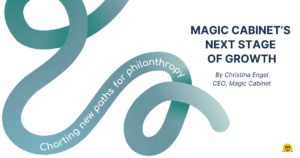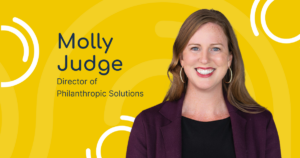
Written by: Wendy Paris | Originally published at InsidePhilanthropy.com | June 13, 2023
The name Magic Cabinet might conjure an image of a cleaning spray that makes wood shine, or maybe some kind of AI-powered kitchen that puts away the dishes by itself.
Actually, the Magic Cabinet we’re focused on is an innovative philanthropy doing an unusual form of participatory grantmaking in Washington State’s Puget Sound and California’s Bay Area. The name comes from founder Ken Birdwell’s youthful fascination with a freestanding video console housing the now-classic game Pong, which he saw in a Seattle mall as child, fell in love with, and could only describe as a “magic cabinet.”
Birdwell went on to work in telecommunications, computer simulation and CAD prosthetics, and then helped start the video game developer, publisher and digital distribution company Valve. While at Valve, he contributed to the wildly popular first-person shooter game Half-Life and the mega-seller Portal, a story-driven puzzle game that has sold more than 4 million copies. In 2018, Birdwell used a chunk of his wealth to found and privately fund Magic Cabinet, an evolution of a 509(a)(3) nonprofit he’d been running since 2011.
Since 2019, Magic Cabinet has given more than $45 million in five-year, unrestricted, capacity-building grants to 21 cohorts of three nonprofits each, or 63 nonprofits total. Each cohort receives about $500,000 a year, depending on their needs and what they ask for. In 2022, the foundation gave out $8.6 million, and is on track to give about $10 million this year.
Magic Cabinet’s approach to grantmaking is as unique as its name. And even though the source of its wealth is a tech wizard, the highly cooperative model is largely influenced by his days working in the nonprofit world.
Developing a new take on participatory grantmaking
Birdwell had spent 20-plus years volunteering, donating to, and working with nonprofits. In that time, he saw the value of their work and the limiting nature of program-specific grants and the troubling power dynamics of much traditional funding. His vision for Magic Cabinet was something different: Don’t just give out money in a top-down way, but rather pull together cohorts of three nonprofits, give unrestricted, capacity-building funds to the group to spend as they see fit, and let them duke it out among themselves.
Okay, they don’t duke it out. Unlike a shoot-em-up video game, the idea here is to foster collaboration, community and mutual support among the three nonprofits in each group. Ideally, members look out for each other and decide, together, who needs what. This may not sound as exciting as, say, playing Grand Theft Auto, but so far, it’s working really well, said Tiffany Johnson, Magic Cabinet’s chief strategy officer.
“At first, they were like, ‘Is it going to be like ‘The Hunger Games?’” she said. It wasn’t. “In the first group, someone presented a proposal for $50,000 and the members were like, ‘That’s not enough. You need more.’”
Trust-based, multi-year, capacity-building grantmaking is definitely state-of-the-art in power-sharing funding, as we’ve written before. And as I recently learned when covering the L.A.-based artist collaborative LAVA, previously overlooked groups can gain real strength through this kind of collaborative model. And the process is participatory, recruiting community members for an advisory committee that chooses the cohorts of grantees, and then allowing those cohorts to decide how to divvy up funding.
But what strikes me as unusual about Magic Cabinet (besides the name) is its cohort model. The closest prominent analog might be the Ford Foundation’s BUILD initiative, which provides flexible, multi-year funding to grantees and connects them to other grantees working in the field to build out a durable network. Magic Cabinet is a little different, though, putting together small, close-knit cohorts, kind of like the funding version of a matchmaker. And, as in even the best-arranged marriages, cohort grantees could find themselves bound to others they didn’t choose, left to craft their mutual fate together.
Doesn’t that sound kind-of, well… top-down?
No, the team told me. Letting these groups make funding decisions among themselves is more participatory than one grantee getting a bunch of dough. And it’s better for the nonprofits to spend time planning how to spend money with a group of their peers than to use those hours to fill out demanding applications for restricted funding, year after year. Magic Cabinet and its advisors basically handle the application process. “It’s a lot more work this way. But it’s worth it to us to do the work so we’re not wasting nonprofits’ time,” said Johnson.
Plus, a lot of thought and effort goes into forming the cohorts. Magic Cabinet’s engagement officers pull together a list of possible nonprofit grantees developed from research, site visits and community conversations. They talk to everyone in the cohort neighborhood, “grasstops folks, grassroots folks,” said Karen Toering, Magic Cabinet’s newly appointed director of advocacy. Then, a diverse advisory council of five or six people, including one or two board members, looks at the “menu” of possible grantees gathered by Magic Cabinet and works together to choose the three groups in the cohort, bringing their own experience and knowledge of the community to the process.
This doesn’t mean cohort members are besties off the bat. Jennifer B. Lyle, executive director of MISSSEY, a member of a 2019 Bay Area-Oakland cohort that focuses on sexual exploitation and violence against Black girls and gender-expansive youth, admitted that originally, she’d wished for different cohort partners. Now? She’s grown to see the wisdom of the funder’s ways. “I see that this is the perfect group because we’ve done so much together. We really do have related concerns.”
Her main reaction, however, was astonishment at being chosen at all. “We thought it was a scam, because nobody gives that kind of money, and nobody reaches out to say, ‘We want to fund you, this women-of-color organization.’ This was before people were funding women-of-color organizations. Tiffany called me twice. I thought, now is not the time for joking around. Because we really, really, really needed the money. Everything that we needed was really capacity-building, and nobody does that. It took me a while, after meeting them. Ken Birdwell was in the room. I Googled him when we were in the room and was like, ‘Okay, this is legit.’ Then it was magical.”
The life-changing magic of capacity-building funds
LaNesha DeBardelaben, president and CEO of Northwest African American Museum (NAAM), a member of the 2020 Puget Sound-Central Area Cohort, said the grant money was “a lifesaver for our organization.” When COVID closed the museum’s doors, the Magic Cabinet funding enabled it to pivot and stay afloat. With unlimited, capacity-building funding, NAAM launched virtual and outdoor programming, expanded its scope regionally, created a wire service and a pop-up mobile library/reading room for kids. “We were able to find an innovative way to reimagine who we are and what we could be as a museum,” she said.
For all grantees, having money to hire people like development directors, accountants, marketers and consultants has freed up executive directors to lead and to do so more creatively. For NAAM, an expanded marketing team contributed to the annual fundraiser, pulling in twice the amount it had the year before the Magic Cabinet Funding, and then another third over that the following year. “We were able to share a case for support that moved people’s hearts,” said DeBardelaben. “We’re literally growing capacity as a result.”
The multi-year funding also has allowed these medium-sized, mostly BIPOC groups to pay employees more and take better care of them by offering things like sabbaticals and retirement funding, making them more competitive with larger, more established (often white-led) organizations. They also can apply for grants that were previously out of their reach, such as ones that require (expensive) data collection and documentation.
In its first five years of existence, Magic Cabinet has given to community-led nonprofits with a track record of at least three years in the community, annual budgets of about $500,000 to $2.5 million, and the need for and ability to deploy capacity-focused grants. Going forward, the foundation is looking to expand the pool to include smaller groups or fiscally sponsored organizations that did not formerly meet its criteria.
MISSSEY’s Jennifer B. Lyle said the funding has allowed her nonprofit to triple its budget, so far — and to begin to break free from a scarcity mindset that, in itself, keeps people down.
“Organizations that are run by Black women, we are less likely to be funded and much less likely to be funded in this way. We are always in debt. To think about it in terms of, ‘What is it like to have so much money that you can be imaginative and thoughtful?’ That’s a strategic and thoughtful way of getting money to organizations. That’s disruptive.”



